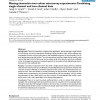Free Online Productivity Tools
i2Speak
i2Symbol
i2OCR
iTex2Img
iWeb2Print
iWeb2Shot
i2Type
iPdf2Split
iPdf2Merge
i2Bopomofo
i2Arabic
i2Style
i2Image
i2PDF
iLatex2Rtf
Sci2ools
BMCBI
2007
2007
Missing channels in two-colour microarray experiments: Combining single-channel and two-channel data
Background: There are mechanisms, notably ozone degradation, that can damage a single channel of two-channel microarray experiments. Resulting analyses therefore often choose between the unacceptable inclusion of poor quality data or the unpalatable exclusion of some (possibly a lot of) good quality data along with the bad. Two such approaches would be a single channel analysis using some of the data from all of the arrays, and an analysis of all of the data, but only from unaffected arrays. In this paper we examine a 'combined' approach to the analysis of such affected experiments that uses all of the unaffected data. Results: A simulation experiment shows that while a single channel analysis performs relatively well when the majority of arrays are affected, and excluding affected arrays performs relatively well when few arrays are affected (as would be expected in both cases), the combined approach outperforms both. There are benefits to actively estimating the key-paramet...
| Added | 08 Dec 2010 |
| Updated | 08 Dec 2010 |
| Type | Journal |
| Year | 2007 |
| Where | BMCBI |
| Authors | Andy G. Lynch, David E. Neal, John D. Kelly, Glyn J. Burtt, Natalie P. Thorne |
Comments (0)

